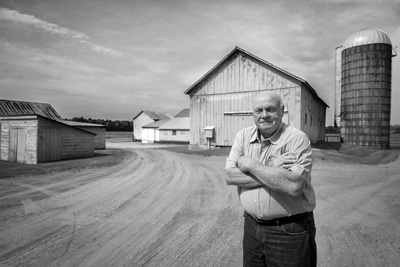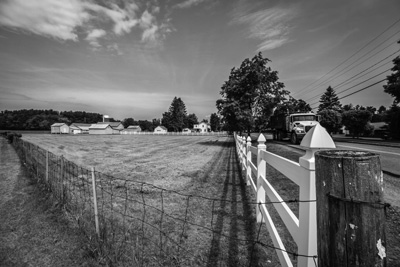News & Issues June 2016
Keeping a farm at city’s edge
New group pushes toward dream of Saratoga Springs agricultural center
 By EVAN LAWRENCE
By EVAN LAWRENCE
Contributing writer
SARATOGA SPRINGS, N.Y.
William Pitney shows off the farm his family has owned since 1862 at the western edge of Saratoga Springs. Pitney is working with a new nonprofit group to turn the property into a community hub for producing local food and learning about agriculture. Joan K. Lentini photo
The freshly planted field off Saratoga Springs’ West Avenue is a developer’s dream: 100 acres of flat, perfectly open land, about a mile and a half from the city’s downtown in one direction and Saratoga Spa State Park in the other, across the street from the YMCA and within walking distance of Saratoga Springs High School.
The Pitney family, which has owned this land since 1862, has a different vision: an active farm conserved in perpetuity, with facilities and programs for engaging the public in local food production and teaching the next generation of farmers.
Although a plan to partner with a local land conservation group fell through in April, a new group has formed to make the Pitney family’s dream a reality.
“We’ve been fighting for this for three or four years,” said William Pitney, who owns the farm with his sisters Judith and Kathy. “The original plan is coming back into focus.”
The Pitney Farm comprises 166 acres on the west side of Saratoga Springs. Most of the land is one huge field leased to Thomas Poultry Farm of Northumberland, which raises feed corn for its hens there. An old railroad bed divides the big field from the white frame farm buildings and a small pasture. To the west, the property continues beyond an active rail line to 30 acres of woodlands bordering two brooks.
“It started as a vegetable farm for the Pitney Hotel in Saratoga Springs,” Pitney said. “Then it was pigs, cows, and dairy cows.”
 For a while in the 1930s the property was the site of a two-runway airport; Pitney has a sign from that era advertising airplane rides for $2.
For a while in the 1930s the property was the site of a two-runway airport; Pitney has a sign from that era advertising airplane rides for $2.
In 1962, Pitney’s father sold the dairy herd and bought a feed business. The farm produced corn, hay and straw until the feed business grew so busy that the Pitneys decided to focus exclusively on that business and quit farming. Thomas Poultry Farm has leased the land since 1991, Pitney said.
The Pitneys have not lived on the farm in many years, but the family has been determined to keep it out of development.
“We want it left agricultural, growing crops,” William Pitney said. “It could provide education for kids and, eventually, a farmers market.”
Agricultural hub
Paul and Sandy Arnold of Pleasant Valley Farm in Argyle credit Mike Kilpatrick with coming up with the idea of a community farm on the Pitney land.
About five years ago, Kilpatrick, who co-owned Kilpatrick Family Farm in Middle Granville, “was looking for a farm close to Saratoga Springs,” Paul Arnold said. “He found the Pitney farm and talked to Bill. He realized it was too big a project for him alone.”
So Kilpatrick talked to the Arnolds, who’d taught him about farming beginning when he was 15, about the idea.
The Pitneys wanted to put a conservation easement on the farm, which would protect it permanently from development, and sell it to someone who would continue to farm it and develop it as an agricultural center. The land was appraised at $2.28 million, of which the Pitneys were willing to donate $500,000. The city of Saratoga Springs had an open space fund that could be used to buy the conservation easement, which was valued at $1.13 million.
The Pitneys, the Arnolds, and Kilpatrick turned to Saratoga PLAN (Preserving Land and Nature), a local nonprofit land conservation group, in hopes that it could raise the remaining $650,000 and hold the land. Saratoga PLAN would have needed additional funds to create and maintain the easement, for a grand total of about $3 million, Sandy Arnold said.
Saratoga PLAN was formed in 2003 by the merger of two previous land conservation groups. It has conserved more than 4,400 acres of farmland, woods, and natural habitats around Saratoga County.
“We do conservation easements on a regular basis,” said Maria Trabka, the group’s executive director.
With farms, she said, “the primary purpose is to conserve the land for agriculture,” but there may be secondary purposes for an easement, such as for protecting streams in the case of the Pitney farm.
“We allow things to occur on the property that are supportive of the easement’s purposes, are compatible with them, and don’t conflict with those purposes,” Trabka explained. “Our philosophy is to get out of the way of the farmers. We let the farmers make the decisions about what to do there as long as they uphold the original purposes of the easement.”
Saratoga PLAN did land surveys and a title search of the farm, conducted structural assessments of the farm buildings, and did legal work to set up the easement. Those costs came to around $100,000, Trabka said. By last winter, the group had secured 87 percent of the necessary funds, including the city’s agreement to bond the purchase of the easement. It was PLAN’s most successful capital campaign ever.
But negotiations between PLAN and the Pitneys broke down.
“We discovered that our views of agriculture were much broader than the Pitneys’,” Trabka said. “We didn’t want to prohibit anything that we couldn’t think of today. The sellers wanted to make sure nothing would happen on the property that they didn’t approve of.”
By late April, Saratoga PLAN’s board of directors decided that continuing the partnership was pointless, and the organization withdrew.
“Many donors have graciously allowed us to keep their donations,” Trabka said. “We hope we’ll at least cover our expenses.”
Trabka said she doesn’t consider the group’s efforts wasted.
“We educated a lot of people in city government and other interested people, and we were active in getting the city to sell open space bonds to buy the easement,” she said.
Trabka also called the Pitneys “fantastic stewards” of their land.
“The family is completely committed to keeping the land as a farm,” she said. “Our work advanced them in that direction.”
Creating a new nonprofit
Undeterred by Saratoga PLAN’s withdrawal, the Pitneys went back to the Arnolds. Kilpatrick had since moved out of the area but agreed with the Arnolds to create a new nonprofit organization, Pitney Meadows Community Farm, to raise funds, buy and run the farm in the way the Pitneys had envisioned.
“The three of us are on the board,” Sandy Arnold said. “We expect to add a fourth person soon.”
The Saratoga Springs mayor’s office did not respond to several phone calls requesting comment for this report, but Sandy Arnold said the city “still wants to work with us.”
“The partners have changed, but we’re still moving ahead,” she said.
The group has arranged with another nonprofit to accept tax-deductible donations until the community farm receives its tax-exempt status.
In addition to being experienced farmers, the Arnolds are active in promoting farming to the public and as a career. They host interns on their fruit and vegetable farm and give presentations at farm conferences around the United States and Canada.
“Our passion is to make new successful farmers and have local produce for our communities,” Paul Arnold said.
The Pitneys, the Arnolds, and Kilpatrick have embraced the community farm model, as opposed to a strictly commercial farm. Some examples of what they’d like to create in Saratoga Springs are The Intervale Farm in Burlington, Vt., the Poughkeepsie Farm Project in New York, and Waltham Community Gardens in Massachusetts.
“There’s a lot of models all across the U.S., but none with all our components,” Sandy Arnold said. “None are in the middle of a city.”
Feeding and teaching
Pitney Meadows Community Farm could grow “fruit, vegetables, maybe some grains, maybe small livestock in the future,” Sandy Arnold said. “We’re working out a lot of options now. We may work with Thomas [Poultry Farm] to continue to use a portion. They use 95 tillable acres. That’s a small percentage of their feed.”
The 12 acres that include the farm buildings would become a teaching and training farm. Small incubator farms could be provided for new farmers, with experienced farmers to oversee them. Community gardens would be open to the public for growing their own vegetables and small fruits.
“Skidmore College and SUNY Adirondack are interested,” Paul Arnold said. “Sustainable agriculture is part of their curriculum.”
One of the barns might be converted into an event building for weddings, conferences and other gatherings that would use products from the farm.
A farmers market is another possibility. Although there are two farmers markets already in Saratoga Springs, “we want a winter farmers market,” Paul Arnold said. “We need a stable location with room and parking.”
The Saratoga Farmers Market is held in the warm months at High Rock Park, but there are plans to build a parking garage right next to it. That could affect the market’s ability to continue at that spot.
The Pitney Meadows farm also could have a farm products hub, a store that would be open all week rather than just the few days that farmers markets are held. The farm could offer crop storage and a processing kitchen where produce could be turned into goods such as salsa or pickles. The farm could host programs for local students to learn where their food comes from.
The corncrib, which William Pitney says is the oldest building on the farm, could become a farm museum. Trails could open the land for recreation and join the farm’s fields and forests to other trails around the city.
“We want to do everything with sustainable and organic practices and renewable energy -- as green as we can get it,” Sandy Arnold said.
“Don’t expect it all to be done in one year,” Paul Arnold warned. “Time will make it evolve into what’s needed most. We have every intention of making the farm be profitable instead of a financial drain.”
Community project
Pitney Meadows Community Farm plans a kickoff later this month, at a time and location to be announced, the Arnolds said. It will have to raise the $650,000 purchase price of the farm plus closing costs and $500,000 for a stewardship fund to manage the easement, Sandy Arnold said.
The Arnolds plan to close on the property on Nov. 1. Although the community farm has a lot of fund raising ahead of it, Sandy Arnold pointed out that Saratoga PLAN had already come close.
“We hope the donors who gave to Saratoga PLAN will consider supporting us,” she said. “We have not had anybody who hasn’t been supportive of the idea.”
The Arnolds had no estimate of what will be required to develop the farm center. Although the buildings are in good shape, the house has been vacant for many years, and the property lacks electrical, water and sewer service.
“We have a tremendous effort just to get utilities in there and renovate the house,” Paul Arnold said.
“We’re in the initial stages of site planning,” Sandy Arnold said. “We should have some proposals at the kickoff.”
Community gardens and trails will probably go in first, in the spring, Paul Arnold said.
“The focus is a community farm,” Sandy Arnold said. “We need the whole community to support it.”
For more information about Pitney Meadows Community Farm, visit www.pitneymeadowcommunityfarm.org.
